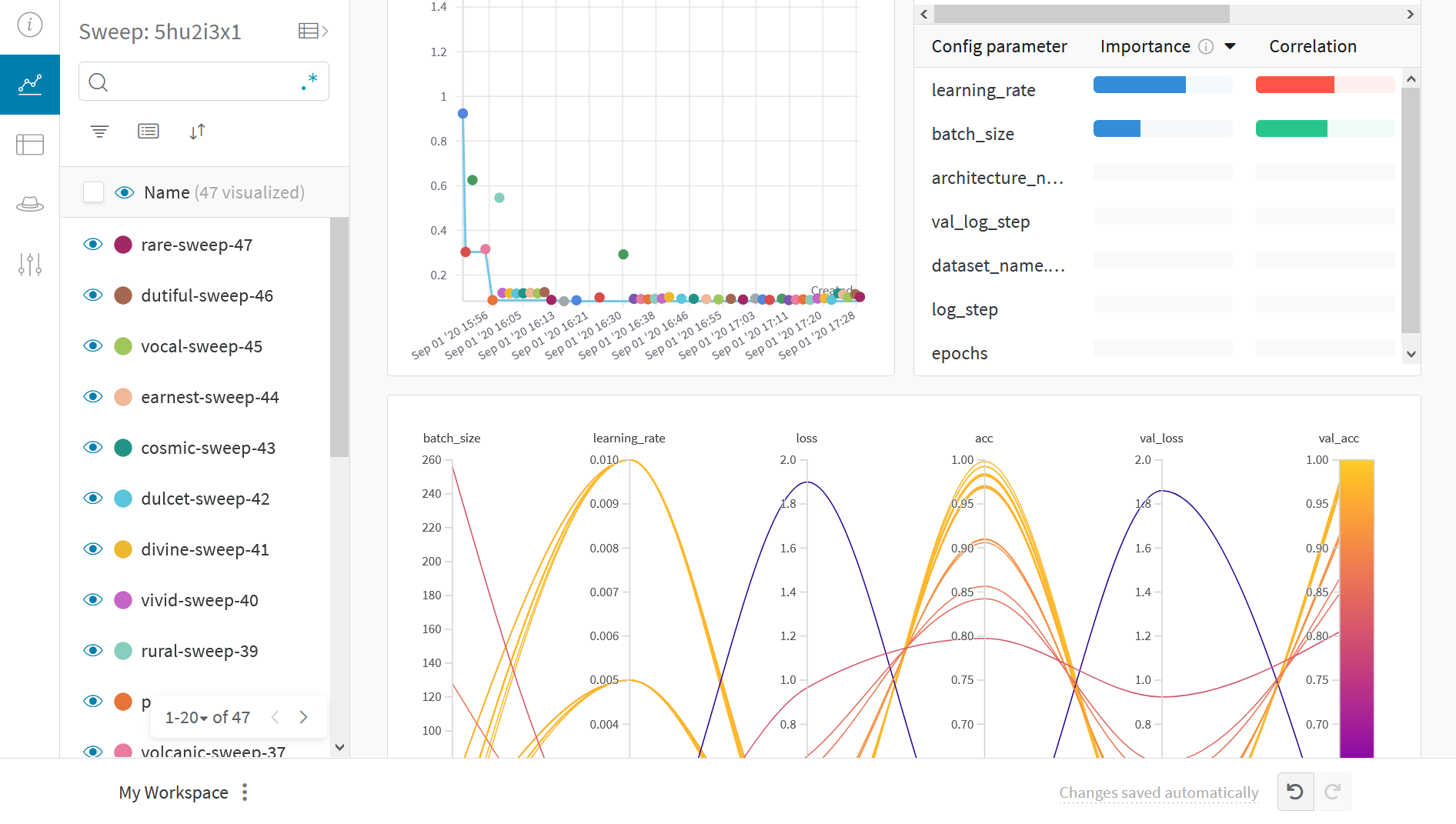TensorFlow Sweeps
4 minute read

Use W&B Sweeps to automate hyperparameter optimization and explore model possibilities with interactive dashboards:

Why use sweeps
- Quick setup: Run W&B sweeps with a few lines of code.
- Transparent: The project cites all algorithms used, and the code is open source.
- Powerful: Sweeps provide customization options and can run on multiple machines or a laptop with ease.
For more information, see the Sweep documentation.
What this notebook covers
- Steps to start with W&B Sweep and a custom training loop in TensorFlow.
- Finding best hyperparameters for image classification tasks.
Note: Sections starting with Step show necessary code to perform a hyperparameter sweep. The rest sets up a simple example.
Install, import, and log in
Install W&B
pip install wandb
Import W&B and log in
import tqdm
import tensorflow as tf
from tensorflow import keras
from tensorflow.keras.datasets import cifar10
import os
import numpy as np
import pandas as pd
import matplotlib.pyplot as plt
import wandb
from wandb.integration.keras import WandbMetricsLogger
wandb.login()
wandb.login() directs to the sign-up/login page.Prepare dataset
# Prepare the training dataset
(x_train, y_train), (x_test, y_test) = keras.datasets.mnist.load_data()
x_train = x_train / 255.0
x_test = x_test / 255.0
x_train = np.reshape(x_train, (-1, 784))
x_test = np.reshape(x_test, (-1, 784))
Build a classifier MLP
def Model():
inputs = keras.Input(shape=(784,), name="digits")
x1 = keras.layers.Dense(64, activation="relu")(inputs)
x2 = keras.layers.Dense(64, activation="relu")(x1)
outputs = keras.layers.Dense(10, name="predictions")(x2)
return keras.Model(inputs=inputs, outputs=outputs)
def train_step(x, y, model, optimizer, loss_fn, train_acc_metric):
with tf.GradientTape() as tape:
logits = model(x, training=True)
loss_value = loss_fn(y, logits)
grads = tape.gradient(loss_value, model.trainable_weights)
optimizer.apply_gradients(zip(grads, model.trainable_weights))
train_acc_metric.update_state(y, logits)
return loss_value
def test_step(x, y, model, loss_fn, val_acc_metric):
val_logits = model(x, training=False)
loss_value = loss_fn(y, val_logits)
val_acc_metric.update_state(y, val_logits)
return loss_value
Write a training loop
def train(
train_dataset,
val_dataset,
model,
optimizer,
loss_fn,
train_acc_metric,
val_acc_metric,
epochs=10,
log_step=200,
val_log_step=50,
):
for epoch in range(epochs):
print("\nStart of epoch %d" % (epoch,))
train_loss = []
val_loss = []
# Iterate over the batches of the dataset
for step, (x_batch_train, y_batch_train) in tqdm.tqdm(
enumerate(train_dataset), total=len(train_dataset)
):
loss_value = train_step(
x_batch_train,
y_batch_train,
model,
optimizer,
loss_fn,
train_acc_metric,
)
train_loss.append(float(loss_value))
# Run a validation loop at the end of each epoch
for step, (x_batch_val, y_batch_val) in enumerate(val_dataset):
val_loss_value = test_step(
x_batch_val, y_batch_val, model, loss_fn, val_acc_metric
)
val_loss.append(float(val_loss_value))
# Display metrics at the end of each epoch
train_acc = train_acc_metric.result()
print("Training acc over epoch: %.4f" % (float(train_acc),))
val_acc = val_acc_metric.result()
print("Validation acc: %.4f" % (float(val_acc),))
# Reset metrics at the end of each epoch
train_acc_metric.reset_states()
val_acc_metric.reset_states()
# 3️⃣ log metrics using wandb.log
wandb.log(
{
"epochs": epoch,
"loss": np.mean(train_loss),
"acc": float(train_acc),
"val_loss": np.mean(val_loss),
"val_acc": float(val_acc),
}
)
Configure the sweep
Steps to configure the sweep:
- Define the hyperparameters to optimize
- Choose the optimization method:
random,grid, orbayes - Set a goal and metric for
bayes, like minimizingval_loss - Use
hyperbandfor early termination of performing runs
See more in the W&B Sweeps documentation.
sweep_config = {
"method": "random",
"metric": {"name": "val_loss", "goal": "minimize"},
"early_terminate": {"type": "hyperband", "min_iter": 5},
"parameters": {
"batch_size": {"values": [32, 64, 128, 256]},
"learning_rate": {"values": [0.01, 0.005, 0.001, 0.0005, 0.0001]},
},
}
Wrap the training loop
Create a function, like sweep_train,
which uses wandb.config to set hyperparameters before calling train.
def sweep_train(config_defaults=None):
# Set default values
config_defaults = {"batch_size": 64, "learning_rate": 0.01}
# Initialize wandb with a sample project name
wandb.init(config=config_defaults) # this gets over-written in the Sweep
# Specify the other hyperparameters to the configuration, if any
wandb.config.epochs = 2
wandb.config.log_step = 20
wandb.config.val_log_step = 50
wandb.config.architecture_name = "MLP"
wandb.config.dataset_name = "MNIST"
# build input pipeline using tf.data
train_dataset = tf.data.Dataset.from_tensor_slices((x_train, y_train))
train_dataset = (
train_dataset.shuffle(buffer_size=1024)
.batch(wandb.config.batch_size)
.prefetch(buffer_size=tf.data.AUTOTUNE)
)
val_dataset = tf.data.Dataset.from_tensor_slices((x_test, y_test))
val_dataset = val_dataset.batch(wandb.config.batch_size).prefetch(
buffer_size=tf.data.AUTOTUNE
)
# initialize model
model = Model()
# Instantiate an optimizer to train the model.
optimizer = keras.optimizers.SGD(learning_rate=wandb.config.learning_rate)
# Instantiate a loss function.
loss_fn = keras.losses.SparseCategoricalCrossentropy(from_logits=True)
# Prepare the metrics.
train_acc_metric = keras.metrics.SparseCategoricalAccuracy()
val_acc_metric = keras.metrics.SparseCategoricalAccuracy()
train(
train_dataset,
val_dataset,
model,
optimizer,
loss_fn,
train_acc_metric,
val_acc_metric,
epochs=wandb.config.epochs,
log_step=wandb.config.log_step,
val_log_step=wandb.config.val_log_step,
)
Initialize sweep and run personal digital assistant
sweep_id = wandb.sweep(sweep_config, project="sweeps-tensorflow")
Limit the number of runs with the count parameter. Set to 10 for quick execution. Increase as needed.
wandb.agent(sweep_id, function=sweep_train, count=10)
Visualize results
Click on the Sweep URL link preceding to view live results.
Example gallery
Explore projects tracked and visualized with W&B in the Gallery.
Best practices
- Projects: Log multiple runs to a project to compare them.
wandb.init(project="project-name") - Groups: Log each process as a run for multiple processes or cross-validation folds, and group them.
wandb.init(group='experiment-1') - Tags: Use tags to track your baseline or production model.
- Notes: Enter notes in the table to track changes between runs.
- Reports: Use reports for progress notes, sharing with colleagues, and creating ML project dashboards and snapshots.
Advanced setup
- Environment variables: Set API keys for training on a managed cluster.
- Offline mode
- On-prem: Install W&B in a private cloud or air-gapped servers in your infrastructure. Local installations suit academics and enterprise teams.
Feedback
Was this page helpful?
Glad to hear it! If you have more to say, please let us know.
Sorry to hear that. Please tell us how we can improve.